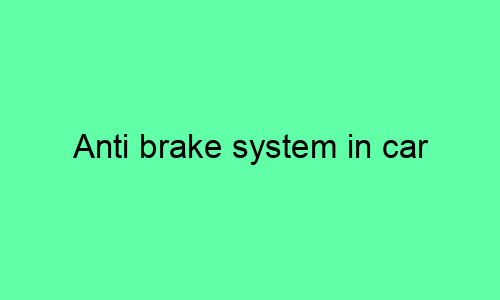**
Anti-Brake System (ABS) in Cars
**
##
What is an Anti-Brake System (ABS)?
An Anti-Brake System (ABS) is a safety feature in cars that prevents the wheels from locking up during braking, allowing the driver to maintain control and steer the vehicle. It does this by rapidly modulating the brake pressure to each wheel, releasing the pressure momentarily when the wheel is about to lock up. This allows the wheel to continue rolling while maintaining maximum braking force.
##
How does ABS work?
The ABS system consists of the following components:
* Wheel speed sensors: These sensors, located at each wheel, measure the speed of the wheel.
* Brake modulator: This device receives signals from the wheel speed sensors and controls the brake pressure to each wheel.
* Brake control unit (BCU): This computer processes the data from the wheel speed sensors and activates the brake modulator.
When the driver applies the brakes, the wheel speed sensors detect if any of the wheels are about to lock up. If so, the BCU signals the brake modulator to release the brake pressure on that wheel briefly. This allows the wheel to regain traction and start rolling again. The process is repeated rapidly, preventing the wheels from locking up and allowing the vehicle to maintain control.
##
Benefits of ABS
ABS provides numerous benefits for drivers, including:
* **Improved directional stability:** ABS prevents the wheels from locking up, allowing the driver to maintain control and steer the vehicle during braking.
* **Shorter stopping distances:** Studies have shown that ABS can shorten stopping distances, especially on slippery surfaces.
* **Reduced risk of skidding:** ABS helps prevent the vehicle from skidding by modulating the brake pressure and maintaining traction.
* **Enhanced driving confidence:** ABS gives drivers more confidence in their ability to handle emergency braking situations.
##
Limitations of ABS
While ABS is an effective safety feature, it has some limitations:
* **Not effective on all surfaces:** ABS may not be as effective on loose surfaces such as gravel or snow, where the wheels can still lock up easily.
* **Increased pedal feel:** ABS can sometimes cause a pulsating or juddering sensation in the brake pedal.
* **Maintenance costs:** ABS systems require periodic maintenance and repair, which can add to the cost of owning a vehicle.
##
How to use ABS effectively
To use ABS effectively, drivers should:
* **Apply firm pressure to the brake pedal:** Do not “pump” the brakes, as this can interfere with the ABS system’s operation.
* **Steer into the turn:** If the vehicle begins to skid, steer into the direction you want to go. This will help the vehicle regain control.
* **Be aware of the limitations:** Do not overestimate the capabilities of ABS, especially on slippery surfaces.
##
When should ABS be turned off?
In certain situations, it may be beneficial to turn off ABS, such as:
* **Driving on loose surfaces:** ABS may not be effective on loose surfaces such as gravel or snow, and it can actually make it harder to stop.
* **Driving in a competition:** Some drivers may choose to turn off ABS in competition settings to gain a performance advantage.
##
Conclusion
Anti-Brake Systems (ABS) are a valuable safety feature that can enhance driving safety and control. By preventing wheels from locking up during braking, ABS allows drivers to maintain directional stability, reduce stopping distances, and minimize the risk of skidding. While ABS has limitations, it is an effective technology that has significantly improved vehicle safety over the years.






